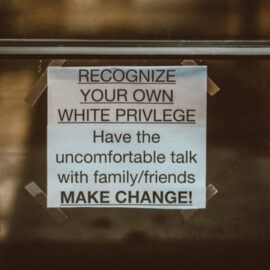

This article is an excerpt from the Shortform summary of "Influence" by Robert B. Cialdini. Shortform has the world's best summaries of books you should be reading.
Like this article? Sign up for a free trial here .
Do you feel safer going out at night when there are people around? Have you heard of the bystander effect? Pluralistic ignorance shows there might not be safety in numbers.
Pluralistic ignorance is a phenomenon in which a group of people behaves contrary to the norms and standards of most of the individual members of that group. The bystander effect is a type of pluralistic ignorance. Learn how to counter the bystander effect.
What Is Pluralistic Ignorance?
In unclear or ambiguous situations, we’re more likely to use the actions of others to model our own behavior. This can lead to a phenomenon called pluralistic ignorance. In these situations, a group of people as a whole acts in a way that most of the individual members of that group would not agree with on their own.
It really comes down to the difference between how a person acts and how people act. Pluralistic ignorance explains the bystander effect, when bystanders fail to help individuals in need.
The Story of Kitty Genovese: A Pluralistic Ignorance Tragedy
In 1963, in the Kew Gardens section of Queens in New York City, a young woman named Kitty Genovese was murdered. While undeniably tragic, what made her murder internationally famous were the circumstances under which it occured.
Genovese was stabbed by her killer over the course of a prolonged 35-minute attack, during which she was audibly in excruciating pain and screaming for someone to help her. Several neighbors in the crowded urban environment either saw or heard portions of the attack. Yet many of them failed to intervene.
The media seized on apathy as an explanation for the neighbors’ behavior. According to this theory, we were becoming a “Cold Society” in which people were unwilling to lift a finger to help each other in an hour of need. Given the attack’s setting in New York City, pundits pointed to apathy as a regrettable feature of modern urban life. They warned that episodes like this would only become more common as the country became more urbanized.
But was this really what was going on? Did these witnesses simply shrug their shoulders at Genovese’s plight? Or was something else going on? Psychologists Bibb Latane and John Darley begged to differ.
They argued that some individual witness struggled to help the victim precisely because they knew there were so many other witnesses. There was a diffusion of responsibility with the bystander effect: everyone assumed that someone else would intervene or call the police, so no one actually did. The knowledge of fellow witnesses lowered the psychological cost of non-involvement for each individual.
They also argued that uncertainty drove the witnesses’ actions (or non-actions). This created pluralistic ignorance.
As we mentioned above, the Social Proof Principle thrives in conditions of uncertainty and ambiguity. In these scenarios, we strongly model our behavior on what others are doing.
In Latane and Darley’s analysis, this created a feedback loop with deadly consequences for Genovese. In the confusing and chaotic atmosphere of a crowded urban environment, Geneovese’s screams could have been any number of things: drunken exuberance, or a lover’s quarrel maybe, neither of which would warrant intervention from a stranger.

———End of Preview———
Like what you just read? Read the rest of the world's best summary of Robert B. Cialdini's "Influence" at Shortform .
Here's what you'll find in our full Influence summary :
- How professional manipulators use your psychology against you
- The six key biases you need to be aware of
- How learning your own biases will help you beat the con men around you






